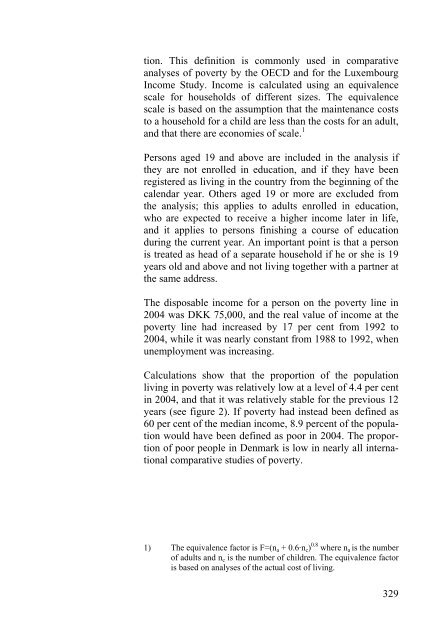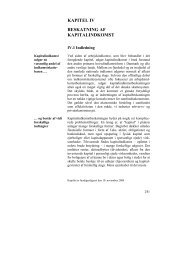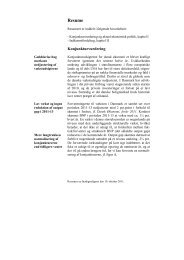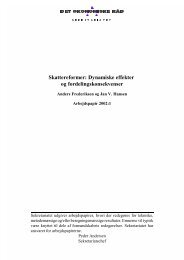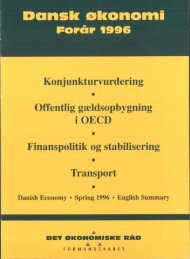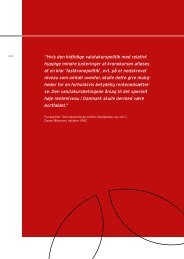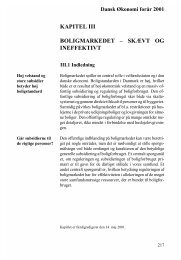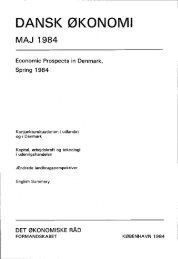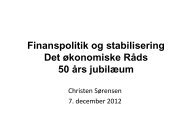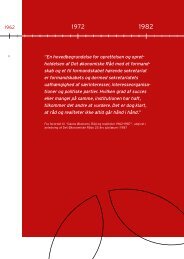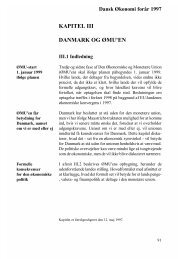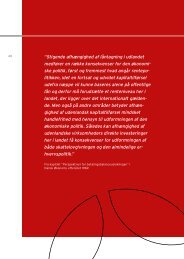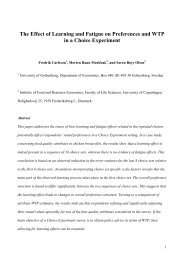- Page 1 and 2:
Dansk ØkonomiEfterår 2006Konjunkt
- Page 3:
Dansk ØkonomiEfterår 2006Konjunkt
- Page 6:
INDHOLDFremsendelsesskrivelse til r
- Page 9 and 10:
Finansministeriets departementschef
- Page 11 and 12:
Formanden for Funktionærernes og T
- Page 13 and 14:
Nationalbankdirektøren var enig i,
- Page 15 and 16:
kante subsidiering af ejerboliger,
- Page 17 and 18:
nyankomne indvandrere. Der er intet
- Page 20 and 21:
forebygge fattigdom gennem en tidli
- Page 22 and 23:
Dansk Økonomi efterår 2006RESUMER
- Page 24 and 25:
Finanspolitikkenbidrager til risiko
- Page 26 and 27:
Fortsættelse afskattestop kanophæ
- Page 28 and 29:
ficere kommuner, der overskrider de
- Page 30 and 31:
elationer. Ud af knap 300.000 perso
- Page 32 and 33:
Børn afindvandrere børprioriteres
- Page 34 and 35:
Forhøjetbeskæftigelsesfradragtil
- Page 36:
tanthjælp i en afgrænset periode
- Page 39 and 40:
Betydelig risiko foroverophedningBe
- Page 41 and 42:
Tabel I.1 Hovedtal i konjunkturvurd
- Page 43 and 44:
Udsigt tilafdæmpet stigningi konta
- Page 45 and 46:
Høje oliepriserInflation pågodt 2
- Page 47 and 48:
Tabel I.2 Skøn for dansk økonomi,
- Page 49 and 50:
Opjustering afbetalingsbalancenFort
- Page 51 and 52:
Boks I.1Mængdeaggregater i faste p
- Page 53 and 54:
Boks I.2SMEC formuleret med kædein
- Page 55 and 56:
Figur I.4Pct.point54Vækst i Danmar
- Page 57 and 58:
Figur I.5Indeks11010510095908580Til
- Page 59 and 60:
Boks I.3Sveriges økonomiske politi
- Page 61 and 62:
Figur I.6a Inflation i Euroland Fig
- Page 63 and 64:
På sigt stigendelang rente iEurola
- Page 65 and 66:
kurs mangler, hvilket kan føre til
- Page 67 and 68:
Boks I.4Det amerikanske betalingsba
- Page 69 and 70:
verdensøkonomien, dvs. om boligmar
- Page 71 and 72:
… til trods forforventning om fal
- Page 73 and 74:
Boks I.5Kontantprisen - den ubekend
- Page 75 and 76:
Fortsat væksti boliginvesteringern
- Page 77 and 78:
Konstant bygningsinvesteringskvoteL
- Page 79 and 80:
Tabel I.4 Eksport og importÅrets M
- Page 81 and 82:
Boks I.6Udviklingen på de danske e
- Page 83 and 84:
Tabel I.5 Lønkonkurrenceevne2005 2
- Page 85 and 86:
Boks I.7Den økonomiske betydning a
- Page 87 and 88:
Lavere overskud påbetalingsbalance
- Page 89 and 90:
fremgang i beskæftigelsen i 2007.
- Page 91 and 92:
Figur I.201.000 pers.29402920Arbejd
- Page 93 and 94:
Figur I.21a Flaskehalse i byggeriet
- Page 95 and 96:
… men ledighedenvurderes ikke atk
- Page 97 and 98:
Tabel I.9 Udvikling i lønomkostnin
- Page 99 and 100:
Boks I.8ProduktivitetsudviklingenPr
- Page 101 and 102:
Oliepriser påvirkerforbrugerpriser
- Page 103 and 104:
Tabel I.12 Den offentlige sektors i
- Page 105 and 106:
Store personskatteogafgiftsindtægt
- Page 107 and 108:
Boks I.9Omsættelige kommunale udgi
- Page 109 and 110:
Udviklingen i offentligt forbrugOff
- Page 111 and 112:
Bestemmelse afBVT i offentligsektor
- Page 113 and 114:
Boks I.10Illustration af real og no
- Page 115 and 116:
Nominel vækst ioffentligt forbrugs
- Page 117 and 118:
Figur I.26a Offentlig beskæftigels
- Page 119 and 120:
Den offentligesektors størrelse er
- Page 121 and 122:
Ændringer ifinanspolitikkenhar alt
- Page 123 and 124:
Offentligeinvesteringerpåvirkereft
- Page 125 and 126:
Standardberegningerserbort fra effe
- Page 127 and 128:
lang sigt øges med 0,8 pct. 10 Det
- Page 129 and 130:
Boks I.11Beskatning og arbejdsudbud
- Page 131 and 132:
Boks I.12Effekt af lavere indkomsts
- Page 133 and 134:
Effekt af de enkelteelementer iskat
- Page 135 and 136:
Boks I.13VelfærdsforligetVelfærds
- Page 137 and 138:
Tabel I.17 Befolkningsudvikling fre
- Page 139 and 140:
½Tabel I.18 Forventede aldersgræn
- Page 141 and 142:
Figur I.30a Offentlig saldo Figur I
- Page 143 and 144:
Boks I.14Forudsætninger bag beregn
- Page 145 and 146:
Forudsætninger og usikkerhedsfakto
- Page 147 and 148:
Individueltoffentligt forbruger his
- Page 149 and 150:
af de sidstnævnte forbehold, er de
- Page 151 and 152:
lønsalderen. Denne overledighed ve
- Page 153 and 154:
Højere vækst ioffentligt forbruge
- Page 155 and 156:
I.9 Aktuel økonomisk politikTempoe
- Page 157 and 158:
verden, hvor kapital og arbejdskraf
- Page 159 and 160:
2010-plan et vigtigtredskab i styri
- Page 161 and 162:
Behov forstramninger pålængere si
- Page 163 and 164:
Omsætteligekommunaleudgiftsrettigh
- Page 165 and 166:
Frederiksen, A., E.K. Graversen and
- Page 167 and 168:
Bilagstabel I.2 Løn- og prisudvikl
- Page 169 and 170:
148Bilagstabel I.4 Hovedposter på
- Page 171 and 172:
150Bilagstabel I.6 Indkomster, forb
- Page 173 and 174:
152Bilagstabel I.8 Eksport og impor
- Page 175 and 176:
154Bilagstabel I.10 Den offentlige
- Page 177 and 178:
således betinget af, at personen i
- Page 179 and 180:
Socialt udsatte- et brederebegrebSo
- Page 181 and 182:
Unge har lavereindkomst endmidaldre
- Page 183 and 184:
vægte forskellige gruppers velfær
- Page 185 and 186:
II.2 Måling og fordeling af fattig
- Page 187 and 188:
Figur II.1Indeks120115Indeks for re
- Page 189 and 190:
Relativ måling ikomparativeanalyse
- Page 191 and 192:
indregnet værdien af at bo i ejerb
- Page 193 and 194:
Figur II.21000 kr.9080Fattigdomsgr
- Page 195 and 196:
Offentligeoverførsler følgersatsr
- Page 197 and 198:
Arbejde eralternativ tiloffentlige
- Page 199 and 200:
Figur II.4aFattige fordelt efter al
- Page 201 and 202:
Tabel II.2 Sandsynligheden for at v
- Page 203 and 204:
Figur II.5 Fattige som andel af bef
- Page 205 and 206:
vandrere kommer, fordi de har et jo
- Page 207 and 208:
pligt, kan indmelde sig i en a-kass
- Page 209 and 210:
Tabel II.3 Påvirkning af sandsynli
- Page 211 and 212:
Indvandrere harhøjere risiko for a
- Page 213 and 214:
Tabel II.4 Sandsynligheden for at f
- Page 215 and 216:
Indvandrereforbliver oftere ifattig
- Page 217 and 218:
Boks II.2Varighedsanalyse af period
- Page 219 and 220:
Tabel II.5Betydning af udvalgte soc
- Page 221 and 222:
Figur II.11Hazard1.000.80MændKvind
- Page 223 and 224:
øvrige del af landet. Det er ikke
- Page 225 and 226:
Figur II.13 Fattige opdelt efter ti
- Page 227 and 228:
Figur II.14 Beskæftigelsesomfang s
- Page 229 and 230:
Figur II.15Andel i pct.8050 pct. gr
- Page 231 and 232:
Figur II.17Andel i pct.6050 pct. gr
- Page 233 and 234:
Figur II.191000 personer12198820041
- Page 235 and 236:
Figur II.20Andel af diagnosticerede
- Page 237 and 238:
II.5 Indvandrere i fattigdomRelativ
- Page 239 and 240:
elativt mange fattige. Andelen af f
- Page 241 and 242:
fordi de bliver berettiget til offe
- Page 243 and 244:
Figur II.26Tilknytningen til arbejd
- Page 245 and 246:
Unge oftere fattigeKlare forskellem
- Page 247 and 248:
Social mobilitetmere præcistBørne
- Page 249 and 250:
kerhed om afkastet som følge af de
- Page 251 and 252:
Boks II.3Sociologiske forklaringer
- Page 253 and 254:
Afhængermobiliteten afplaceringen
- Page 255 and 256:
Tabel II.8Socioøkonomiske faktorer
- Page 257 and 258:
Tabel II.9Samvariation mellem sønn
- Page 259 and 260:
viser således, at døtrenes indkom
- Page 261 and 262:
nes markedsindkomster ret meget for
- Page 263 and 264:
danske døtre ligger på niveau med
- Page 265 and 266:
aggrund betyder mere for læsefærd
- Page 267 and 268:
pålægges også et loft over, hvor
- Page 269 and 270:
Forsørgere har enmeget begrænset
- Page 271 and 272:
sen er foretaget som en simpel samm
- Page 273 and 274:
ledighedsforløbet. 21 Graversen (2
- Page 275 and 276:
skuddet for f.eks. familier med to
- Page 277 and 278:
estemt fagområde, sådan at de i s
- Page 279 and 280:
ikke sikkert, at han ville opleve e
- Page 281 and 282:
Ej korrigeret foromfanget afarbejds
- Page 283 and 284:
indkomstmæssigt, hvor smedene har
- Page 285 and 286:
Uddannelse og jobkan være snævert
- Page 287 and 288:
Mænd tjener mereend kvinderLæger
- Page 289 and 290:
Færre selvstændigeend tidligereSe
- Page 291 and 292:
II.9 Sammenfatning og anbefalingerV
- Page 293 and 294:
stilles. Det gælder i særligt sto
- Page 295 and 296:
gangsformer. Den indførte obligato
- Page 297 and 298:
Forhøjetbeskæftigelsesfradragtil
- Page 299 and 300: Ansættelse medløntilskudBekæmpel
- Page 301 and 302: Poverty among Immigrants to Denmark
- Page 303 and 304: Generational Income Mobility in Nor
- Page 305 and 306: male immigrants. International Jour
- Page 307 and 308: Rawls (1971): A Theory of Justice.
- Page 309 and 310: 288
- Page 311 and 312: Økonomi- og ErhvervsministerietFor
- Page 313 and 314: på de offentlige finanser og betal
- Page 315 and 316: Det er fortsat en central udfordrin
- Page 317 and 318: miske incitamenter. Der fremlægges
- Page 319 and 320: Dansk ArbejdsgiverforeningDansk øk
- Page 321 and 322: De seneste tal for den økonomiske
- Page 323 and 324: I kapitel II ”Fattigdom i Danmark
- Page 325 and 326: DI deler Vismændenes tanker om, at
- Page 327 and 328: ningen nok først og fremmest finde
- Page 329 and 330: marginalskattens betydning for arbe
- Page 331 and 332: ejdsudbudseffekter. Vi konstaterer
- Page 333 and 334: vendigt at sikre en mere effektiv o
- Page 335 and 336: - men også de mere kortsigtede. Me
- Page 337 and 338: Funktionærernes og Tjenestemænden
- Page 339 and 340: overveje om man ikke også skulle s
- Page 341 and 342: er derfor, ligesom introduktionsyde
- Page 343 and 344: unemployment is expected to result
- Page 345 and 346: Policy recommendationsThe forecast
- Page 347 and 348: approximately half of the initial f
- Page 349: in public consumption, the system c
- Page 353 and 354: the dependent variables. The analys
- Page 355 and 356: alternative is to prescribe a lower


